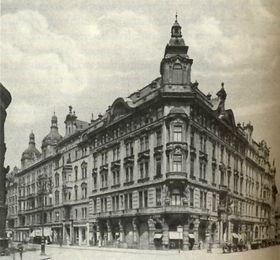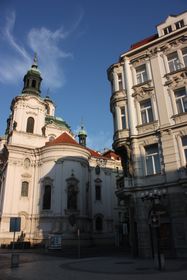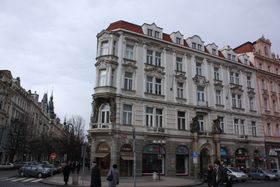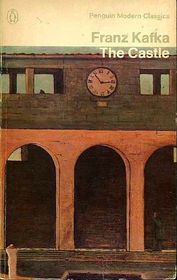Old Town Square 12, Old Town
 The Oppelt-House in 1935
From November 1913 on the family Kafka lived in the uppermost floor of the Oppelt House, a neo-baroque apartment house from the turn of the 20th century built by Otakar Materna and Rudolf Kříženecký. In the wake of the battles fought around the Old Town Hall the house was heavily damaged in 1945 and was restored in 1946 without the top floor. Thus the apartment the Kafkas lived in is no longer in existence.
The Oppelt-House in 1935
From November 1913 on the family Kafka lived in the uppermost floor of the Oppelt House, a neo-baroque apartment house from the turn of the 20th century built by Otakar Materna and Rudolf Kříženecký. In the wake of the battles fought around the Old Town Hall the house was heavily damaged in 1945 and was restored in 1946 without the top floor. Thus the apartment the Kafkas lived in is no longer in existence.
From his room Kafka could look down on the already high-class Nicholas Street: “I have, by the way, a beautiful view, which you can perhaps imagine on occasion, in your good feeling for topography is matched by an equally good memory. Straight ahead out my window on the 4th or 5th floor I have the great cupola of the Russian Church (St Nicholas’ Church in the Old Town) with two towers and between the cupola and the next apartment building a little triangular cut-out view of the Laurenziberg (Mount St Lawrence) with a very small church on it. To the left I see the Town Hall with its tower in its entire enormity rising up sharply and laying itself back in a perspective view in a way that no person has perhaps really seen yet.”
 The Oppelt-House with the opposite Church of Saint-Nicolas
The Oppelt House, too, had a woman custodian, which was not unusual for a palatial apartment building of this size. Kafka devoted a diary entry to her little dog: “The poodle of the janitress who sits on a step downstairs, listening to the tramping of my feet beginning on the fourth floor, who looks at me, when I arrive at his side and looks after me when I walk on. Pleasant feeling of familiarity, since he is not startled by me and includes me in the house he’s used to and in his noise.”
The Oppelt-House with the opposite Church of Saint-Nicolas
The Oppelt House, too, had a woman custodian, which was not unusual for a palatial apartment building of this size. Kafka devoted a diary entry to her little dog: “The poodle of the janitress who sits on a step downstairs, listening to the tramping of my feet beginning on the fourth floor, who looks at me, when I arrive at his side and looks after me when I walk on. Pleasant feeling of familiarity, since he is not startled by me and includes me in the house he’s used to and in his noise.”
 In his later years which were already marked by illness Kafka returned into the care of his parents who were still living in the Oppelt House. Since Ottla was in Siřem and later attended an agricultural college in Frýdlant, Kafka was able to live in her room: “Your bedroom is not a bedroom. I won’t say anything about the kitchen, nothing about the courtyard, at ½ 7 it’s noisy, that is all a matter of course, even if today is Sunday. By the way, not even the cat could be heard, just the clock in the kitchen. But above all the bathroom. Three times according to my count the light was turned on there and water was turned on for incomprehensible purposes, then added to all that the door to the bedroom was left open so that I heard Father coughing. Poor Father, poor Mother, poor Franz.”
In his later years which were already marked by illness Kafka returned into the care of his parents who were still living in the Oppelt House. Since Ottla was in Siřem and later attended an agricultural college in Frýdlant, Kafka was able to live in her room: “Your bedroom is not a bedroom. I won’t say anything about the kitchen, nothing about the courtyard, at ½ 7 it’s noisy, that is all a matter of course, even if today is Sunday. By the way, not even the cat could be heard, just the clock in the kitchen. But above all the bathroom. Three times according to my count the light was turned on there and water was turned on for incomprehensible purposes, then added to all that the door to the bedroom was left open so that I heard Father coughing. Poor Father, poor Mother, poor Franz.”
 During the time he was at Oppelt House, Kafka wrote a great deal of stories – both short and long - such as “The Hunger Artist”, and above all his longest piece: the unfinished novel The Castle. And just as his father could look out the window of the apartment with pride at his life’s work – the shop in Kinsky Palace, from the same window Franz could look at most of the places where he had spent his life. His Hebrew teacher, Friedrich Thieberger, confirms this: “Once when we were looking from the window down at the square, Kafka pointed out and described specific buildings: ‘That was my high school, and behind it there you can see the university, and a bit further on the left is my office. This small circle – and his fingers traced a pair of small rings – encloses my whole life.’”
During the time he was at Oppelt House, Kafka wrote a great deal of stories – both short and long - such as “The Hunger Artist”, and above all his longest piece: the unfinished novel The Castle. And just as his father could look out the window of the apartment with pride at his life’s work – the shop in Kinsky Palace, from the same window Franz could look at most of the places where he had spent his life. His Hebrew teacher, Friedrich Thieberger, confirms this: “Once when we were looking from the window down at the square, Kafka pointed out and described specific buildings: ‘That was my high school, and behind it there you can see the university, and a bit further on the left is my office. This small circle – and his fingers traced a pair of small rings – encloses my whole life.’”
